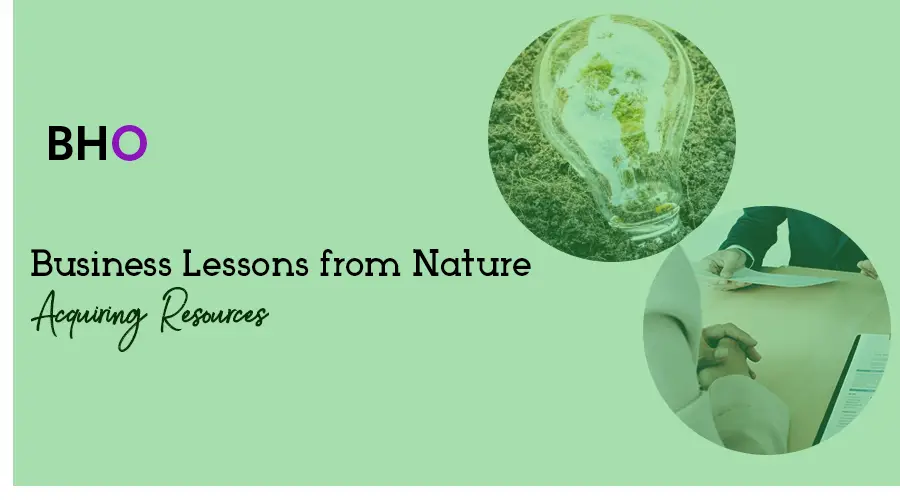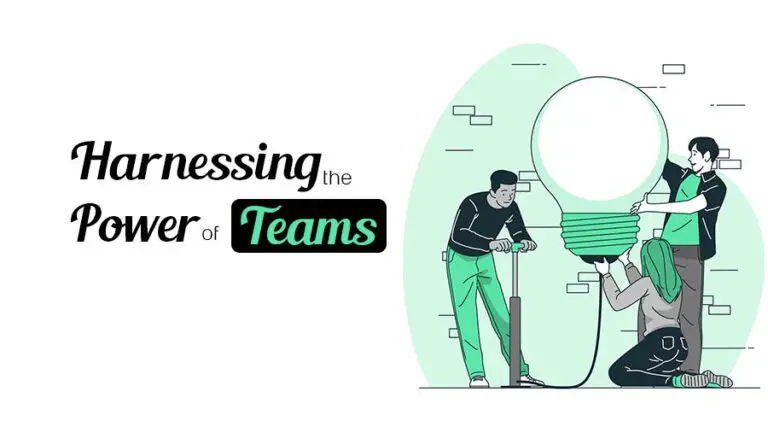Business Lessons from Nature: Acquiring Resources
Startups need to position themselves well to be able to get the resources needed for growth
Ashish Takkar
Businesses have a lot of parts, and for a business to succeed, all these parts must be functioning optimally. One of such parts is the acquisition of resources. Without this, the business will starve and die out. In this post, I will be exploring what resources are, how resources are gotten in nature, and what type of resources are needed for business success.
Table of Contents
What are resources?
Resources are a source of supply or support; available means that enhance the quality of human life. They serve as natural features or phenomena that enhance the quality of human life. They are natural and universally used in providing something useful. Resources are usually valuable and are used as a source of aid or support that may be drawn upon when needed
Business Resources?
Business resources are the basic factors of production, and inputs into the production process in each organization.
Resources are a kind of supply that can be drawn on by a person or organisation in order to function and execute plans and projects. Resources can be in the form of money, material, staff, energy, expertise, time and management, among other things.
Resource is a broad term and its definition varies across fields — economics, biology and ecology, computer science, management, and human resources. In economics, resource is defined as a service or other asset used to produce goods and services that meet human needs and wants. Also referred to as factors of production, economics classifies resources into four categories — land, labour, capital and enterprise. More recently, technology has also been recognised as a factor of production.

Types of Business Resources
The types of business resources are divided into four different types :
- Physical Resources
- Human Resources
- Intellectual Resources
- Financial Resources
1) Physical Resources
These are considered as tangible assets which the organization uses to create value offering and value proposition to its customers. Physical resources may include the equipment, buildings, inventory, the manufacturing plant and distribution network which are extremely crucial for the business to function properly. Without these no business can strive (not even online businesses.)
2 ) Human resources
Employees are considered in the most underrated Assets of any organization. They are important for the functioning of any organization without which the activities of an organization will come to a standstill. Human resources are even more important in the industries which provide services since a great deal of creativity and knowledge is required in those domains.

Human resources are also very crucial in online businesses for customer services, troubleshooting, feedbacks and even the operations of the systems put in place.
3 ) Intellectual resources
These are the types of business resources that are nonphysical and intangible in nature like patents of the product, brands of the organization, copyright over important materials and even partnerships. Customer data and customer knowledge and even the talent in the organization as a form of intellectual resource.
4 ) Financial resources
These often include cash, credit, and lines of credit along with the ability to have options of stock plans for the employees of the organization. Most of the businesses have financial resources on a regular basis but few companies will have extremely strong financial resources such as the banks which are based entirely on financial resources and use them as a key resource.
As a matter of fact, none of these types of resources is inevitable. No Business organization can be without these four types of resources and not even a small scale business. All of these must be available in a different ratio.
Acquisition of Resources in Nature
Most life principles are taught by nature. Acquiring a resource is one of them. And one of the most organised works of nature is Bee.
Bees are very productive insects and are intentional about every move yielding drastic results. Honey bees collect pollen and nectar as food for the entire colony, and as they do, they pollinate plants. Nectar stored within their stomachs is passed from one worker to the next until the water within it diminishes. At this point, the nectar becomes honey, which workers store in the cells of the honeycomb.
Although the main diet of honey bees is comprised of honey and pollen, they collect other liquids and juices from plant and fruit exudates as well. If they encounter insects that secrete honeydew, honey bees collect these liquids and store them as honey. However, when there is no pollen, nectar or honeydew available, honey bees may also collect and store plant spores and dusty animal feed as they would nectar or pollen.
Honey bees have a wide range of nutritional requirements, including vitamins, minerals, lipids, proteins and carbohydrates. Honey bees need these nutrients for taking care of their young, the development of young workers and the overall survival of a colony. Honey and nectar collected by bees contain both sugar and carbohydrates, which produce energy. This energy is converted to body fat and is stored for future use during cold weather. Honey bees obtain necessary vitamins from royal jelly, pollen and various microorganisms within the hive. If worker bees collect and store significant amounts of pollen, a colony has no need to seek out alternate protein sources.
Studying the above clearly, the four types of resources are shown. The physical resources; their hives, honeycomb and even their own bodies. They have themselves readily available to perform their tasks, this can be related to human resources. The intellectual resources; their well-organised colony and the pollination of plants after collecting nectar is proof of this.
Finally, the financial resources; these are the nectar, liquids and juice from plants, fruit exudates and the honeydew can be related to this.
Businesses and Acquisition of resources
For a business to strive, aquisition of resources is crucial. The four types of resources are required for projects to be carried out in businesses.
- Resource management plan:
This is needed to acquire resources. Need to know what kind of resources needed, when are they needed, in what quantities needed et al. - Procurement management plan,
Provides information about who is potentially supplying some of the resources needed for the project and those involved? - Cost baseline for all the budgetary information.
- Schedule, to know by when resources are needed, and when they can be relieved.
- Resource calendar
This tells us the availability of resources, holidays, planned time outs of people, maintenance schedule, schedule constraints and so on. - Resource requirements document, no questions asked.
- Stakeholder register – team members are also stakeholders, for one. Then we need to know which stakeholders can wield influence to acquire resources for us. Their needs and requirements need to be met as well.
- Enterprise environmental factors that contribute are the company’s staffing status – information about people in the company with their skills, competencies, availability, and cost. Policies are related to outsourcing, remote working, facilities extended to people working as virtual teams (located in different geographies), etc.
Other policies of the organization that may affect team acquisition will be the Organizational process assets to be considered.
How do I acquire resources?
- Pre-assignment from other projects
When you are able to get a commitment on required people to come on board when you need them to, you have them pre-assigned to your project. When this happens you go ahead and update the staffing plan with information such as specific names and committed start date, availability duration. - Negotiation with another project/functional managers
Most often than not this is the main technique that comes into play to get the people needed for the project. In a matrix organization, the project manager may need to negotiate with functional managers or resource manager to allocate the right people for the duration needed on the project. If getting consultants, you need to negotiate on getting competent people at good rates with the consulting organization. The same holds good if you are looking to outsource part of the product to a vendor company – negotiation becomes a key factor to get suitable procurement contract terms in place. - Acquire resources from outside the organization
Acquisition here refers to getting people from outside the organization on a consulting basis, or even giving out the work as a subcontract to another company. This happens when competent people are not available within the organization or they are assigned to other projects with no possibility of contributing to your project.
Comprehensive Case Study – The Coca Cola Company.
The Coca Cola Company (Coke), established in 1944, is based out of Atlanta, Georgia and produces Coca Cola, an carbonated soft drink.

On careful study Cocacola is very big on acquiring resources from nature. This case study examines the acquisition of resources from several fronts.
Coca-Cola requires a number of natural resources to serve as ingredients. These include water, carbon dioxide (with which the water is carbonated), sugar, corn (which is utilized for high fructose corn syrup), and phosphate rock (used for the phosphoric acid).
The farming of the corn and sugar, and the mining of the phosphate. The drink itself is actually mixed by machines, but labor is required to run, clean, and maintain.
Physical resources
The Coca Cola company has manufacturing buildings such as factories to make sure the companies items/ stock are produced to the best quality and that the employees are in a safe working environment; it doesn’t have to be presentable to the customers since no one but the employees and employers are allowed to visit the place.
The building is used for machinery use which is advanced and supports the staff. The manufacturing factories consist of departments such as; ICT and Production because these are the departments mostly needed to produce Coca Cola products with safety and efficiency that include facilities with equipment of different kinds of machinery and equipment of production.
The ICT departments of manufacturing would include equipment such as large machinery for; bottling, labelling, filling, packaging etc. also space and equipment to stock the products after manufacturing, this department differs from the production department for example because they’re departments take different roles which mean they need different apparatus to manage.
The production department facilities include testing equipment, lab safe desks and chairs and laboratories for experimenting and such, this Coca Cola’s department is different to the ICT manufacturing department mainly because it’s more accessible to employees and not mainly controlled by ICT technology.
Coca Cola also has warehouses to keep their products in a safe location for preparation to be delivered to customers, the warehouses usually supply big supermarket stores such as; Tesco and Sainsbury’s in England because they order a lot of stock and increase Coca Cola’s profit.
The warehouses are usually very large, high stock rooms with a lot of capacity which helps the company use up their facilities wisely; not wasting resources and money.
Intellectual resources
Intellectual property rights at Coca Cola let people within the company to express their ideas and have the right to be concerned to what happens to these ideas, this includes; how often it may be used, what and who they associate with also, if they have permission to be copied. *the five types of intellectual property; designs, drawings, text, music & video; these different types of communication are enclosed with laws of copyright and patening and also- should be protected just like any other copyrighted Coca Cola’s material.
This can impact Coca Cola’s performance by not letting another company steal their ideas by copying their intellectual property- this means that Coca Cola will be taking the credit for the property as well as earning their deserved profit.
Human resources
The company has maintained a heavy focus on managing its people strategically. As of 2018, Coca Cola employed 62,600 people of which 11,400 were employed in the United States.
The company apart from paying good salaries has also made attractive benefits including financial and non-financial available to its employees throughout the world.
Moreover, it spends a large sum each year on the training and development of its people. Coca Cola has an excellent performance management system in place to manage the performance of its employees worldwide. It is using digital tools for the training and development of its employees and has also implemented several training and exchange programs.
Inside the organization, Coca Cola has maintained an environment of continuous learning and a culture that fosters diversity and inclusion. The brand was ranked 28th best employer for women for 2019 as well as 33rd among the world’s best employers for 2018 by Forbes.
Financial resources
Coca-cola company is said to practice a Debt-to-equity ratio and Financial Strategies
Coca Cola is using funds from issuing debt and issuing stocks. Coca Cola believes that its ability to generate cash from operating activities is one of its fundamental financial strengths.
They expect cash flows from operating activities to be strong in 2007 and in future years. Accordingly, Coca Cola expects to meet all of their financial commitments and operating needs for the foreseeable future.
Also, Coca Cola expects to use the cash generated from operating activities primarily for dividends, share repurchases, acquisitions and aggregate contractual obligations.
Coca Cola also has used debt financing for their operations. Coca Cola maintains debt levels they consider prudent based on cash flows, interest coverage ratio and percentage of debt to capital.
Coca Cola uses debt financing to lower its overall cost of capital, which increases their return on shareowners equity.
Final words…
Aquiring resources for business might not be as hard as we think if only we can see through nature and apply what we see into our businesses.





